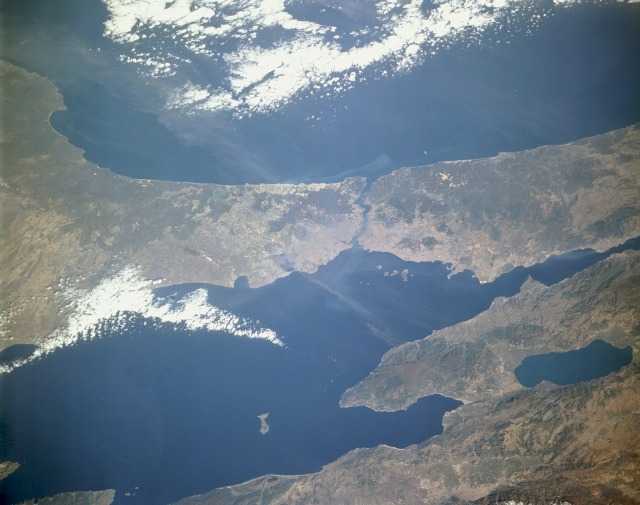|
|
|

This island chain, in Marmara Sea was certainly inhabited from the most ancient times but the islands are first mentioned 4th century b.c. by Aristotle. However during their centuries of existence, the islands were not to know the importance and significance which would be given them by tragic events of their Byzantine period. Cedrenus attributes their princely name to Justinus Kouropalates who owned the greatest island, Prinkipo island, and in 569 a.d. he built there a palace. The islands are about 10 miles distant from the harbour of Constantinople and always have been inhabited: in order of distance they are Proti, Antigoni, Chalki and Prinkipo.
The islands managed to retain their ancient names and Greek identity up to the beginning of the 20th century. In 1922 the Greeks after thousands years of existence in Minor Asia, Pontus, Kappadokia were forced to leave their land, with exception of Constantinople, Imvros, Tenedos and Prince Islands where Greeks numbered about 300000.
But the lootings of September 1955,the deportations of Greek citizens ten years later and the terror of turkish system, would force the christian minorities to abandon the Prince Islands. The turkish state forced also Kurds and people from Black Sea to emigrate to these islands, and today only a small number of Greeks live there.
Proti:
Artemidorus of Ephesus in 2th century b.c. was first to refer to Proti island. It is called
Proti, which means first because was the first of Prince islands to meet a traveler in
antiquity. The history of Proti is linked with the memory of four brillant personalities of
Byzantium. General Bardanes, in 803 was forced to retire to the island, after an unsuccesfull
conspiracy against Nicephorus Logothetes, and he lived as a monk in a small cell of a monastery.
In 813, after the unsuccesful campaign against Bulgarian Kroummus, the emperor Michael Rhangabes was confined to a monastery of Proti, where he spent the rest of his life. Romanus Lecapenus was exiled also in the island in 944 and he became also a monk. Romanus Diogenes a descendant of one of the great aristocratic and military families of Cappadokia, after his tragedy in Mantzikert in 1071, was dethroned by his political rivals, the nobleman Ioannis Doukas and Michael Psellus. They tortured him and murdered him in a Monastery of island Proti.
Antigoni:
Proti is followed by the island of Antigonos, second in location. Travelers were impressed
by the view of the monastery of the Theokoryphotos which was built during the reign of Basil
I the Macedon and looked like a tower. That is why Ottomans called the island Burgaz ada,
Castle island. The monastery continued to function after the fall of Constantinople up to 1630
when it was destroyed by fire at the orders of Sultan.
In 20th century the Orthodox population was more than 1500 residents, and now only 15 Greeks still remain in the island.
Chalki:
At the beginning of the 9th century, at a time when Byzantine dromons (warships) still
ploughed undisturbed through the sea of Marmara, Theodore Studites was imprisoned, and
confined in the monastery of the Holy Trinity. After the destruction by wild and barbaric
Russians in 860, Patriarch Photios reconstructed the monastery. The monastery in a later period
for about 150 years would develop into the theological school of the Great Church of Christ.
After 1961, various pressures and prohibitions made the normal funnctioning of the school dificult. finally, in 1971, the theological department stop functioning, and since then, despite all the steps taken by the Patriarchate of Constantinople the school remains closed.
Prinkipo:
Prinkipo, largest of the four islands of Propontis, is rich in history, in memories
and in beauty as the chroniclers refer to it from the begining of the 6th century.
In 775 Leo IV, was established on the throne of the imperial city. He died and remained on the throne Irene from Athens, dynamic, ambitious and clever. In 802, during the iconoclastic period, armed conspirators seized her and confined her in a monastery of Prinkipos, where she died on the 9th August, 803. During the first years of the reign of the emperor Leo the Armenian another supporter of icon-worship Theodore Studites was confined to Prinkipo.
Prinkipos was set on fire in April 1182, during the reign of Andronicus Comnenus, by Latins as a reprisal for the massacres and lootings which their settlements had suffered at the hands of Greek mob.
According to Kritoboulos, on the 17th of April, 1453, Greeks defended themselves on three towers and refused to surrender. Turkish admiral ordered the towers to be set to flames and the fighters were forced to surrender. He beheaded them and sold the people of Prinkipo into slavery.
The events of 6th of September 1955 and the expulsions of the greek citizens in 1965,
weakened the already decimated community of Prinkipo. The National Orphanage closed
its gates and the extensive monasterial lands around it were expropriated. Today
only 40 elderly Greeks (Romeoi) have remained.
Biblography
The Prince Islands by Akylas Mylas